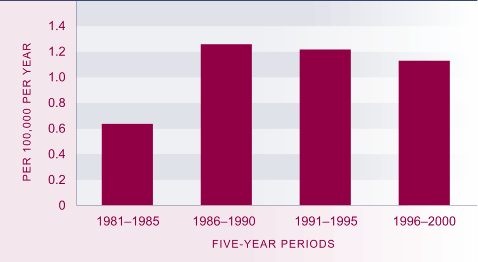Intentional injury child mortality
Definition
The number of children under 15 years of age who have died as a result of an intentional injury, per 100,000 children under 15 years.
Relevance
Children and young people have a need for, and an entitlement to, safety and security in which to grow and develop. Abuse or violence is the ultimate failure to provide this. This indicator directly measures violence against children leading to death and acts as a proxy for non-fatal forms of child maltreatment.
Current level and trends
In the five years to 2000, 49 children under 15 years of age died as a result of maltreatment. On a population basis, this represented an average of one child per 100,000 each year. The five-year average annual rate almost doubled in the late 1980s and has changed very little since then.
Figure SS1.1 Five-year average annual maltreatment mortality rates for children under 15 years, 1981–1985 to 1996–2000

Source: Ministry of Health, New Zealand Health Information Service (ICD–9 codes E960–E969, ICD–10 codes X85–Y09)
Notes: [1] Causes of death include fight, brawl, rape, corrosive or caustic substances, poisoning, hanging and strangulation, submersion (drowning), firearms and explosives, cutting and piercing instruments, child maltreatment and other assault [2] Rates are based on small numbers and should be interpreted with caution
Age and sex differences
Rates of death from maltreatment are higher for children under 5 years of age than for older children. In the five years to 2000, more than two children per 100,000 under 5 year olds died each year as a result of maltreatment, compared with less than one per 100,000 5–14 year olds each year.
There is little difference between the sexes in overall maltreatment death rates.
Table SS1.1 Five-year average annual maltreatment mortality rates for children under 15 years, by age and sex, 1991–1995 and 1996–2000
| Five-year period |
0-4 years |
5-9 years |
10-14 years |
| Male |
Female |
Total |
Male |
Female |
Total |
Male |
Female |
Total |
| 1991-1995 |
1.9 |
2.4 |
2.1 |
0.6 |
0.6 |
0.6 |
1.5 |
0.2 |
0.8 |
| 1996-2000 |
2.8 |
2.0 |
2.4 |
0.4 |
0.8 |
0.6 |
0.6 |
0.1 |
0.4 |
Source: Ministry of Health , New Zealand Health Information Service
Ethnic differences
In the five years from 1996 to 2000, Māori children died from maltreatment at an average annual rate of two per 100,000 children. Over the same period, non-Māori children died at an average annual rate of one per 100,000 children.
International comparison
A UNICEF study of child maltreatment deaths in rich nations in the 1990s reported that New Zealand had the third highest child maltreatment death rate (1.2 per 100,000), behind only the United States and Mexico (both 2.2 per 100,000). This finding should be treated with caution because the very small numbers involved produce highly volatile rates. In addition, although the figures come from the same data source (the World Health Organisation) and use the same international classification of death by cause, there may be differences between countries, and within countries over time, in the classification of death by intention.
|

